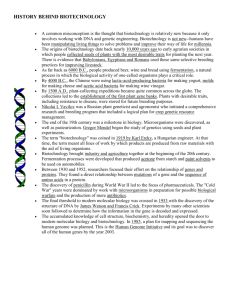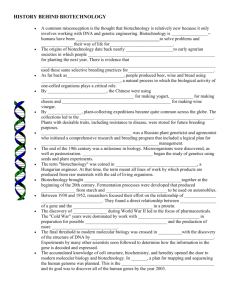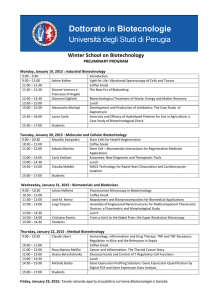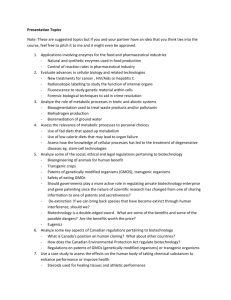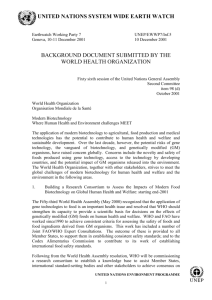pengantar bioteknologi pertanian
advertisement
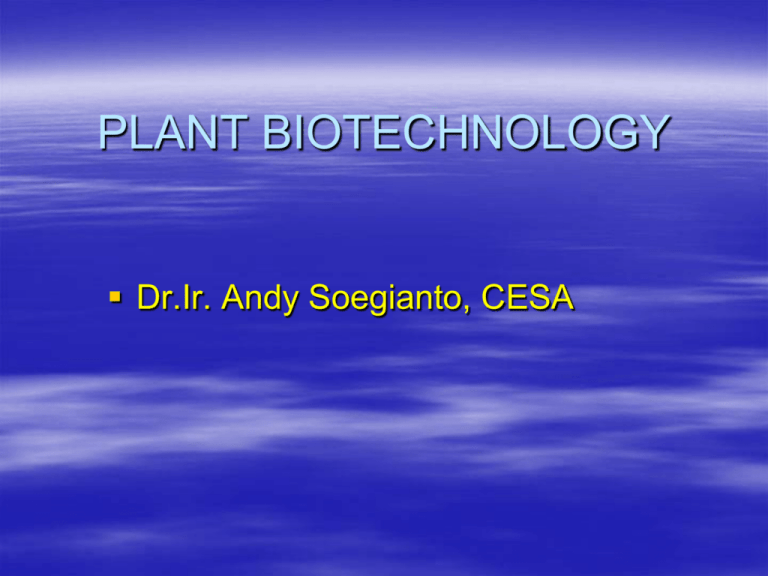
PLANT BIOTECHNOLOGY Dr.Ir. Andy Soegianto, CESA What is Biotechnology ? Use of living organisms to solve problems or make useful products Use of cells and biomolecules to solve problems or make useful products Almost anything to do with biology & technology Use of living organism or parts of them to produce industrially goods or services Molecular Biology Molecular Genetics Microbiology Cell Biology Biochemistry Engineering Processes Biotechnology Health Diagnoses Fermentation Industry Pharmaceutical Industry Chemical Industry Environment and Energy Food and Animal Feed Industry Progression of Biotechnology The Era before Louis Pasteur Alcoholic drinks (Beer, Wine, Palm-wine) Fermented Food (Cheese, yoghurt, tape, tempe, petis, terasi) Progression of Biotechnology The Era of Louis Pasteur Alcohol (Ethanol, Butanol, aceton, glycerol) Organic acids (Citric acid, acetic acid) Aerobic waste treatment Progression of Biotechnology The Era of Antibiotics Antibiotics (Penicillin, tetracyclin, streptomycin) Vaccine (NCD, polio) Steroid Transformation (DOPA) Liquid Medium Fermentation Technology Animal Tissue Culture Technology Progression of Biotechnology The Era of Post-Antibiotics Amino Acids (Glutamic Acid, Lysin, aspartame) Single Cell Protein Enzyme (Amylase, Glucose isomerase, Glucose dehydrogenase) Cell and Enzyme Mobilization Technology Anaerobic liquid waste treatment technology (Biogas) Polisaccharide bacteria (Xanthan, Trehalosa) Progression of Biotechnology Modern Biotechnology Era 1973, The gene can be cloned for the first time 1974, Cloned gene expression on different organism 1975, monoclonal antibody (Hybridome Technology Technology of diagnostic test using antibody Genetic Engineering Artificial vaccine Insulin from alcoholic drink The Most Used Terms in Modern Biotechnology Transgene – Strange gene which is inserted into a species Example – Cry gene (gene codes for toxic protein for Coleoptera) Transgenic organism – an organism contains of transgene by the process of biotechnology (not a cross as in plant breeding process) Example – Bollgard cotton Herbicide resistant maize PRODUCTS OF MODERN BIOTECHNOLOGY IN AGRICULTURE GMO - Genetically modified organisms An organism which has a new trait that is not found before as a result of addition of gene derived from another organism. Also called as Transgenic organism Pest resistant Maize Bt toxin content can kill a corn borer Gene controls toxin production is derived from bacteria Normal Transgenic Cry gene designation Toxic to these insect orders CryIA(a), CryIA(b), CryIA(c) Lepidoptera Cry1B, Cry1C, Cry1D Lepidoptera CryII Lepidoptera, Diptera CryIII Coleoptera CryIV Diptera CryV Lepidoptera, Coleoptera Virus resistant plants papaya, orange, potato Resistance Gene is derived from virus Herbicide resistant plants already exist: soybean, maize, canola next: sugarbeet, cabbage, strawberry, alfalfa, potato, wheat Resistance Gene is derived from bacteria HERBICIDE TOLERANCE CROPS (HTCs) Herbicide Commercial Name Bromoxynil Buctril Glyphosate Roundup Glufosinate Sulfonylureas Imidazolinones 2,4-D Sethoxydim Triazines Herbicide Tolerant Crops cotton, potato, tobacco sugar beet, corn, cotton, lettuce, canola, soybean, tobacco, tomato, wheat Liberty, alfalfa, sugar beet, corn, barley, melon, peanut, Ignite, Basta rice, canola, soybean, tomato, wheat corn, cotton, tobacco, tomato, flax, soybean, sugar beet corn, canola, wheat potato, sweetgum, cotton corn canola The Differences between Plant Biotechnology and Plant Breeding Plant Biotechnology Plant Biotechnology allows the plant breeder a wider choice of traits to choose from and allows the trait to be realized in a more precise manner and within a shorter time period. Conventional plant breeding • Can only use genes from within one species or several closely related species or wild species, becoming a limitation due to loss of genetic diversity • Takes many years to develop an improved variety Interspecific crossing in Plant Breeding Wheat Rye X Triticale New species, but NOT as result of Modern Biotechnology process Mutagenesis: New trait, without a strange gene Mutagenesis changes DNA sequences of a gene allow to get a new advantageous trait Mutagenesis treatment Gene target ATTCGA New Gene ATTGGA “While traditional breeding approaches have worked well, they can be very time consuming and sometimes inefficient. Each plant has tens of thousands of genes, so crossing two plants results in a multitude of combinations. With advances in technology, scientists can now precisely identify through marker technology some of the individual genes responsible for producing a particular characteristic. Traits such as fruit color or resistance to a particular pest, make breeding new varieties quicker and more precise. Table 1. Areas of Biotech Crop Growth 2004 COUNTRY USA Argentina Canada Brazil China South Africa India Paraguay Uruguay Australia Romania Spain Mexico AREA (m Ha) 47.6 16.2 5.4 5.0 3.7 0.5 0.5 1.2 0.3 0.2 0.1 0.1 0.1 CROP Cotton, Maize, Soybean Soybean, Maize, Cotton Canola, Maize, Soybean Soybean Cotton Maize, Soybean, Cotton Cotton Cotton Soybean, Maize Soybean Soybean Maize Cotton, Soybean WHAT’S THE DIFFERENCE AND THE SIMILARITY BETWEEN HORSE AND SNAIL??? WHAT’S THE DIFFERENCE AND THE SIMILARITY BETWEEN GRASSHOPPER AND RICE??? WHAT’S THE DIFFERENCE AND THE SIMILARITY BETWEEN SALMONELLA AND PINE TREE??? ORGANISM ORGAN SYSTEM ORGAN TISSUE CELL ORGANELLES (MITOCHONDRIA, VACUOLE, GOLGI BODY, NUCLEUS, ETC.) GENETIC MATERIAL (DNA) GENETIC MATERIAL MATERIALS USED FOR TRANSMITTING THE GENETIC INFORMATION FROM AN INDIVIDU INTO ITS OFFSPRING HOW DO THE DNA DETERMINE THE CHARACTER OF LIVING ORGANISM? DNA TRANSCRIPTION TRANSLATION PROTEIN Character structure and process in an organism All processes directed by enzymes Enzyme the largest part of the protein. WHY A CHARACTER CAN BE ENGINEERED?? ……………………………… WHY IS GENETIC ENGINEERING PROSPECTIVE ?? KARENA KESAMAAN STRUKTUR MOLEKUL DNA PADA SEMUA MAKHLUK HIDUP MEMUNGKINKAN REKAYASA (PEMINDAHAN, PENGGANTIAN, PENGURANGAN, PENAMBAHAN) DARI SUMBER DNA YANG BERBEDA Assignment for Each Student Essay on Reviewing some journals on the application of Plant Biotechnology Type it using MSWORD : 10 pages minimum, 1.5 spacing, Times New Roman 12” Save in a directory named as your name and Student Identity Number Be gathered in next 2 weeks (week 3th) Will be presented in week 5th Thank You See you next week
